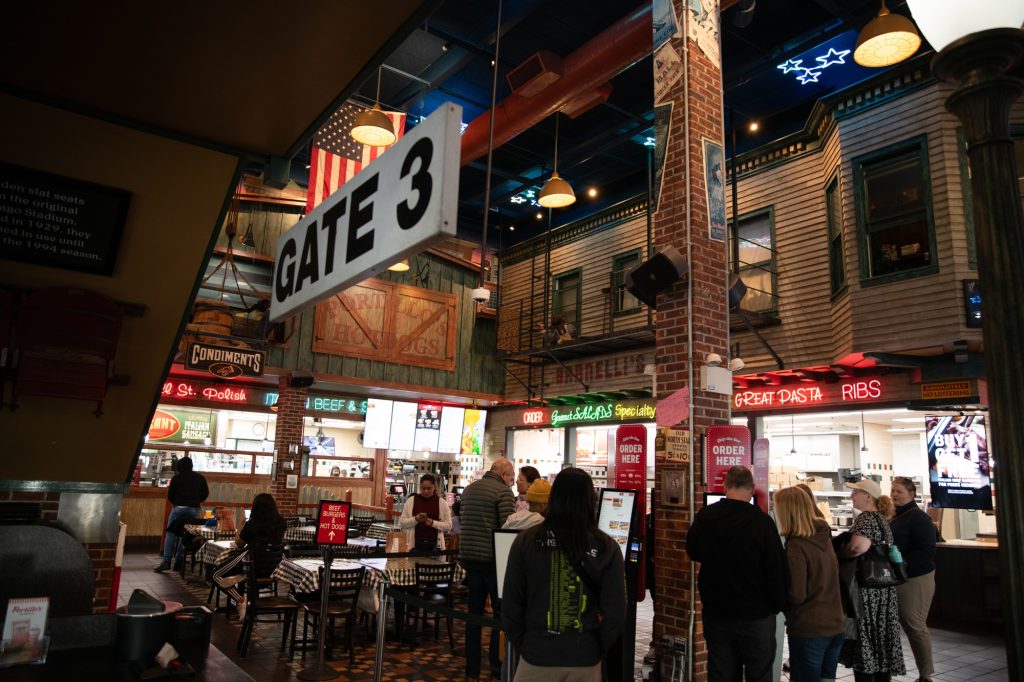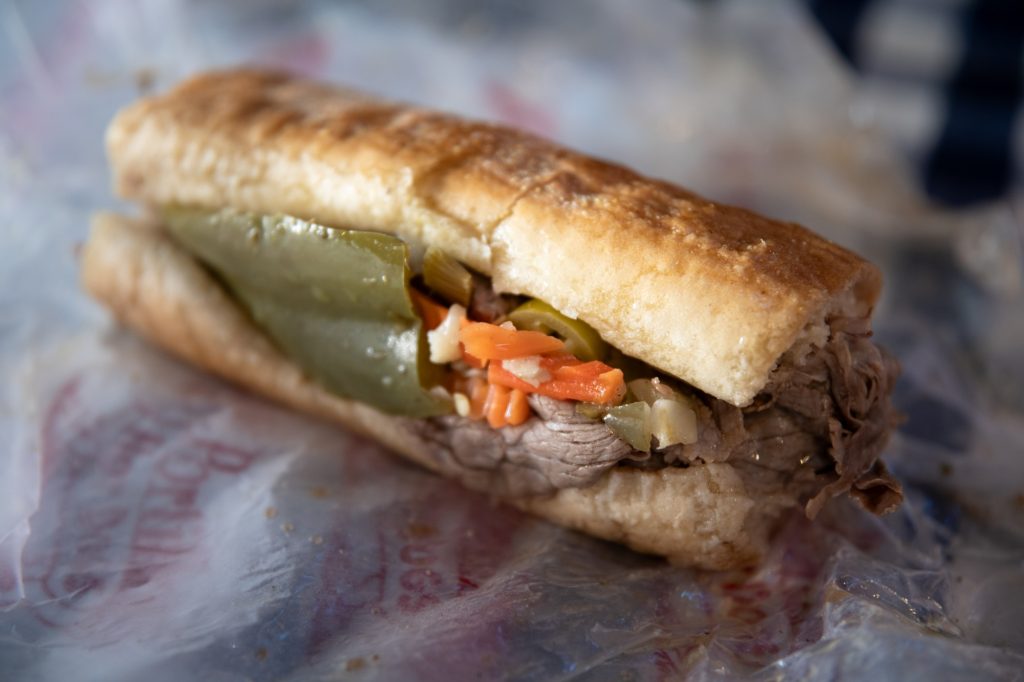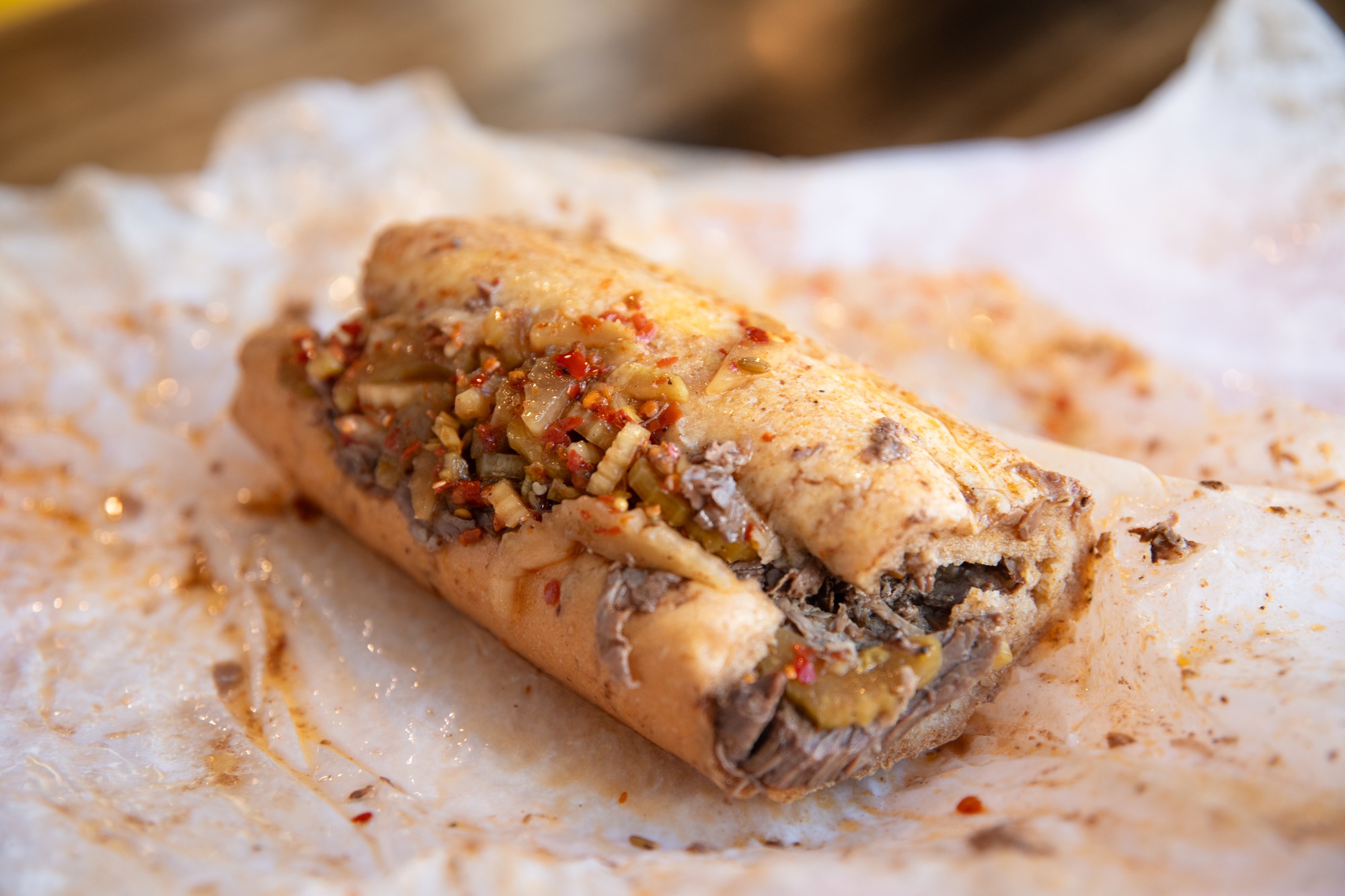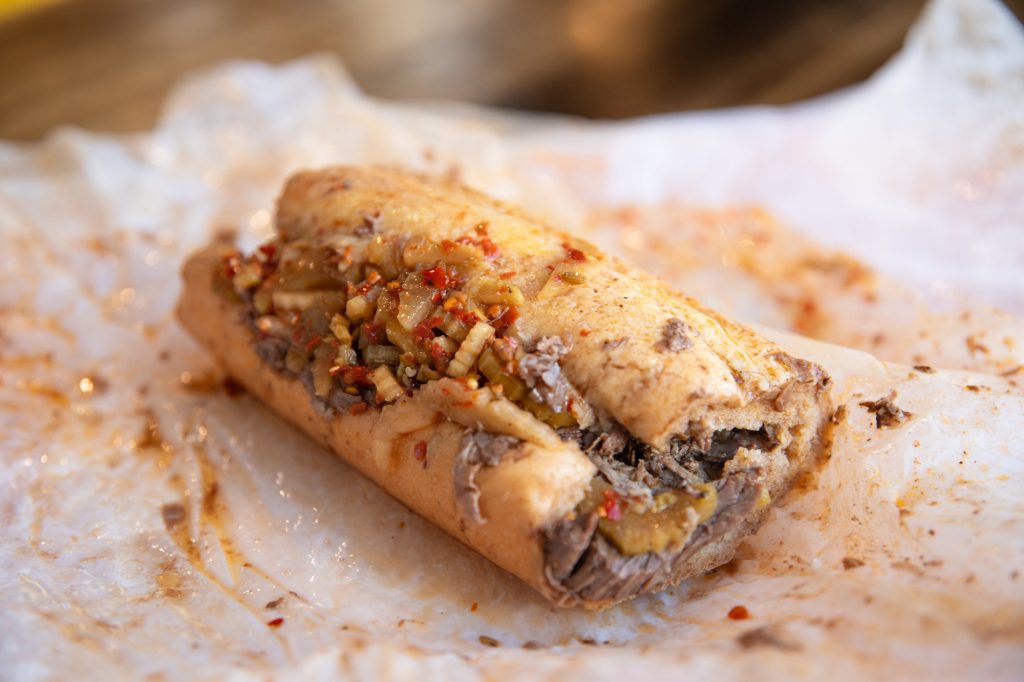The lifeblood of Chicago isn’t blood at all, it’s au jus. These natural beefy juices course through the city’s cultural veins like its many rivers and get sopped up by the bread – that is, native Chicagoans and hungry travelers alike. While there are many shops that serve the classic Italian beef sandwich, two stand apart, as they are on opposite ends of the spectrum.

Al's Beef presents a more everyday atmosphere to its chain, reflecting its longstanding history in the city. Photographed by Finn Martin/BruinLife.

Al's Beef squashes this beef between the two rival Chicago chains. Photographed by Finn Martin/BruinLife.
As any local will tell you, Al’s Beef is an institutional hookup for this iconic dish. Started by Al Ferreri in 1938, he got the idea for the sandwich after he realized that thinly slicing roast beef with a deli slicer and cooking it in its own juices could not only feed more people than a traditionally thicker slab but also tasted pretty darn good. Business and the Italian beef’s popularity have only boomed since the restaurant’s inception. With four locations in addition to the original in Little Italy, Al’s is an awarded institution from the likes of Food Network and Playboy magazine and a – if not the – definitive institution to get your Italian beef fix.

Fronting a mixture of carnival meets fast-food, the Chicago Portillo's is a sight to see. Photographed by Finn Martin/BruinLife.
That said, small fries turn to big beef with the introduction of Portillo’s. Despite its humble beginnings that saw Dick Portillo sling sausages out of a trailer in 1963, his restaurant has expanded to include over 70 locations nationwide as of 2025 – two of which are in California! Portillo’s is truly a behemoth. The massive menu includes everything from Italian beef to Polish sausages to seasonal cakes. Its interior is a fun house of eclectic decorations, vintage signage and impressively tall ceilings.
Having met the matchup, it’s time to find out who’s got the better beef.
At both Al’s and Portillo’s, the sandwiches were ordered correctly, that is to say dipped with hot giardiniera. Portillo’s also had a sweet pepper, but they will not be a deciding factor. Visually, Al’s is the better looking of the two, as the giardiniera overflows from the slit of the au jus-soaked French roll. Proportionally, they were about the same and filled with comparable amounts of beef and peppers. Onto the meat of the matter, where Portillo’s is a uniformly thin slice, Al’s had pieces that resembled more of a chopped brisket. In terms of taste, both were juicy and tender, though Al’s had a slightly stronger beefy flavor.
While both of these sandwiches were dipped into the beef gravy, Al’s was noticeably wetter. If there were no peppers, I would not have had to chew the delicately sloppy sandwich. Portillo’s, on the other hand, had a bit more textural variety. Some parts were a definite delicious mush, while other parts of the bread still had some bite to them. While this is entirely up to personal preference, I do enjoy when the roll still has a bit of structural integrity.

The dipped Italian Beef Sandwich, nicely packed and peppered. Photographed by Finn Martin/BruinLife.
On to the peppers: the deciding factor. The giardiniera at Portillo’s is noticeably spicier than the one at Al’s. In light of this, the spicy acidity of the topping was able to cut through the fatty beefiness of the Portillo’s sandwich, where at Al’s it was not. Another note is that the giardiniera from Al’s was noticeably oilier. While I understand that this vegetable mixture is stored in oil, it should have been drained a little better because this did lead to a bit of a smelly issue. See, when the fats in oil break down over time, it becomes rancid and starts to release unpleasant aromas. In this particular instance, that aroma was uncomfortably similar to fecal matter. While the sandwich did not taste of poop, it vaguely smelled of it. Because smell does play a role in the enjoyment of food, Portillo’s takes the cake in the Italian beef category.
You know what Portillo’s also takes the cake in? Cake! Specifically, their famous Chocolate Cake Shake. This drink – that you eat with a spoon, so maybe it’s more of a custard – takes a vanilla milkshake and blends an entire slice of decadent chocolate cake into it. The rich creaminess of the shake is taken to new heights when married to the rich fudginess of the cake chunks – this is where the spoon comes in. These chunks sink to the bottom of the beverage like buried treasure that you get to unearth with, an admittedly too flimsy, plastic spoon. While this drink is essentially enjoyed much the same way as a melted scoop of brownie batter ice cream, it makes it all the more better as a dipping sauce for Portillo’s incredibly salty French fries.

Crinkle cut fries that make up for their lack of structure with their weight of salt. Photographed by Finn Martin/BruinLife.
Where the fries at Portillo’s are crinkle cut, Al’s are straight shoestring. Portillo’s fries – which I got for free because I am a proud Portillo’s Perks member – while super salty in a good way, did lack a crispy exterior. Crisped to an almost extreme, Al’s fries came in hot, salty and easily wolfable – their contrast came in their thinner, crisped design.
A lot can change between the two buns of a hot dog, even the dog itself. Al’s Beef presents the Original Depression Dog, a toned-down version of the heavily garnished Chicago Dog that brings in only mustard, relish, onion, sport peppers and a poppy seed bun. For the tactile-inclined eater, the poppy seed bun adds a physical twist to this experience, and the hot dog snaps down with a satisfying bite. These simple condiments also work wonders, bringing in a zesty pack that heightens the chomping texture of this dog. Portillo’s Char-Grilled Polish Sausage shares the mustard, onions, relish, poppy seed bun and even the sport peppers – but for some reason failed to produce a unique moment. Maybe it was the exhaustion of the day, maybe it was the ambience that verged on tackiness, but the only good thing about this sausage was its bite and its preparedness – a win for the Polskis but maybe not Portillo’s.

The Polish Sausage that's buried beneath caramelized onion and mustard. Photographed by Finn Martin/BruinLife.
At the end of the day, each establishment has something distinct to offer. Portillo’s is a more touristy hullabaloo of eclectic decor and a vast and eccentric menu, and its Italian beef is top notch. Al’s, on the other hand, while a franchise, still holds true to its roots and delivers great executions on the Chicago classics – except when its namesake item smells like tomorrow’s problems. If you can only visit one, Al’s squashes this beef.



